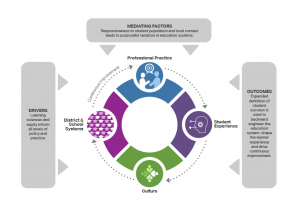Levers and Logic Models: A Framework to Guide Research and Design of High-Quality Competency-Based Education Systems
CompetencyWorks Blog

Levers and Logic Models: A Framework to Guide Research and Design of High-Quality Competency-Based Education Systems was released by iNACOL and CompetencyWorks today. We developed the logic model in response to the call from researchers and practitioners at the National Summit on K-12 Competency-Based Education.
Although I’m listed as a co-author, I want to be very clear that this work was led by Katherine Casey with tremendously valuable input from Wendy Surr (AIR) and Eric Toshalis (Students at the Center/Jobs for the Future). Other members of the Logic Model for CBE Technical Advisory Group who contributed to this include: Kim Carter, Jennifer Charlot, Cory Curl, Elena Diaz-Bilello, Theresa Ewald, Pat Fitzsimmons, Laurie Gagnon, Virgel Hammonds, Laura Hilger, Dina Klein, Chris Liang-Vergara, Rebecca Midles, Joy Nolan, Ace Parsi, Susan Patrick, Amelia Peterson, Linda Pittenger, Andresse St. Rose, Sydney Schaef, Samantha Sherwood, and Jonathan Vander Els.
Four things to be aware of when you are ready to read this paper:
1) The logic models are an advanced approach to building understanding about what competency-based education is. It is not written for newbies. Even the most advanced practitioners are going to want to plan to take a break and read the paper in two different sittings because of how many concepts have been integrated into one paper. And…it does not provide information on how to implement it. I know people are hungry for an implementation playbook but we think understanding comes first.
2) The logic models describe a high quality competency-based system. This means some elements are ones you would expect to see in any high quality system. We do identify distinguishing features developed with the help of the Technical Advisory Group convened to create a shared understanding of competency-based education. However, if we only used distinguishing features, we have found that people may believe that is all they need to do to be competency-based…and quality suffers. Therefore, given how important quality is to effectively serve students and to sustain efforts to advance competency-based education, we created comprehensive logic models.
3) The discussion on the levers (outcomes, mediating contexts, and drivers) is just as illuminating as the logic models. I found my thinking shifting as we clarified the forces that shape competency-based education systems. We realized there were two drivers – learning sciences and equity – that were important to making just about every decision in a school. The work the TAG did on identifying a set of cornerstones of the learning sciences is incredibly powerful, and I believe that districts and schools can use that to engage their teams in thinking to what degree (or not) their schools, instruction, and assessment are based on the learning sciences.
The discussions made me realize that equity wasn’t simply a moral stance but an educational one. Yes, I probably should have understood that earlier…but I simply didn’t. It comes down to this: If you want every student to succeed, then it is important to draw on all the equity strategies – instructional ones as well as those that are designed to deconstruct inequity and bias – to make sure historically underserved students get the best education possible.
4) The paper is dense. At times it is mind-blowingly dense because we tried to pack all the complexity of what it means to help students learn into the paper. This means you should think about ways to engage with the ideas in the paper, such as:
- Printing it out and engaging with the text by writing your questions, disagreements, examples of what your school does or doesn’t do, etc. on the paper;
- Take it in bite size pieces. Sit down to read the distinguishing features and then stop for a bit. Then go read the section on levers. And then later go read the logic models.
- Find a colleague or a team to discuss it. We offer a few reflection questions along the way to get you started, but we think that people will need to create reflection questions based on their own stage of development and understanding.
Finally, if the ideas presented here just feel too overwhelming … Just Wait! At the end of the summer we will be releasing a paper on the quality principles, which will help you build your understanding of competency-based education without your mind melting.